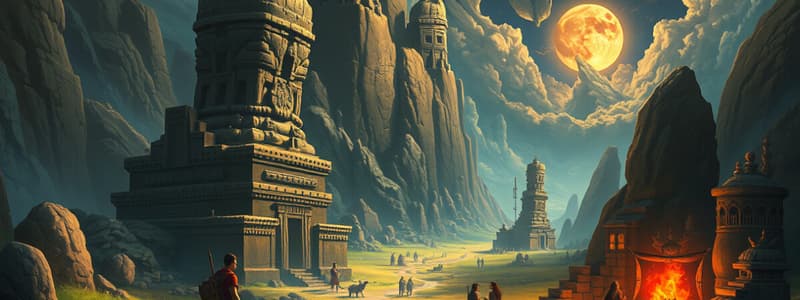Podcast
Questions and Answers
Humans lived on Earth without leaving a written record for roughly ______ million years.
Humans lived on Earth without leaving a written record for roughly ______ million years.
2.5
The Prehistoric Period is generally categorized into three archaeological periods: the Stone Age, Bronze Age, and ______.
The Prehistoric Period is generally categorized into three archaeological periods: the Stone Age, Bronze Age, and ______.
Iron Age
During the Paleolithic period, early humans lived in caves or simple huts and were primarily ______ and gatherers.
During the Paleolithic period, early humans lived in caves or simple huts and were primarily ______ and gatherers.
hunters
Early humans used basic stone and bone tools, as well as crude stone axes, for hunting ______ and wild animals.
Early humans used basic stone and bone tools, as well as crude stone axes, for hunting ______ and wild animals.
They cooked their prey, including woolly mammoths, deer and ______, using controlled fire.
They cooked their prey, including woolly mammoths, deer and ______, using controlled fire.
Ancient humans in the ______ period were the first to leave behind art.
Ancient humans in the ______ period were the first to leave behind art.
During the Paleolithic period, humans used a mixture of minerals, ochres, and ______ to create art.
During the Paleolithic period, humans used a mixture of minerals, ochres, and ______ to create art.
The Mesolithic period is also known for the introduction of small stone tools, often attached to ______, bones, or wood.
The Mesolithic period is also known for the introduction of small stone tools, often attached to ______, bones, or wood.
Agriculture was introduced during the ______ period, leading to more permanent settlements.
Agriculture was introduced during the ______ period, leading to more permanent settlements.
The Neolithic period saw ancient humans switch from hunter/gatherer mode to ______ and food production.
The Neolithic period saw ancient humans switch from hunter/gatherer mode to ______ and food production.
During the Bronze Age, metalworking advances were made with the discovery of ______, a copper and tin alloy.
During the Bronze Age, metalworking advances were made with the discovery of ______, a copper and tin alloy.
The harder bronze replaced its stone ______ during the Bronze Age, leading to better tools.
The harder bronze replaced its stone ______ during the Bronze Age, leading to better tools.
The Bronze Age also brought about the invention of the ______ wheel.
The Bronze Age also brought about the invention of the ______ wheel.
Home dwellings evolved into roundhouses with circular stone walls and a ______ or turf roof.
Home dwellings evolved into roundhouses with circular stone walls and a ______ or turf roof.
Textiles in the Bronze Age mainly consisted of wool items such as skirts, kilts, tunics, and ______.
Textiles in the Bronze Age mainly consisted of wool items such as skirts, kilts, tunics, and ______.
Flashcards are hidden until you start studying
Study Notes
Overview of Prehistoric Ages
- Human existence on Earth spans roughly 2.5 million years before the emergence of written records.
- Prehistoric period dates from approximately 2.5 million years ago until around 1,200 B.C.
- Divided into three main archaeological periods: Stone Age, Bronze Age, and Iron Age.
- Significant developments include tool invention, agricultural advancements, and early art and religion.
The Stone Age
-
Comprises three sub-periods: Paleolithic, Mesolithic, and Neolithic.
-
Paleolithic (2.5 million years ago - 10,000 B.C.)
- Early humans lived in caves or simple structures; practiced hunting and gathering.
- Utilized basic stone and bone tools, and made crude stone axes.
- Cooked meals using controlled fire; prey included woolly mammoths and deer.
- First known examples of art included cave paintings and carved figurines.
- Ended with the last Ice Age, causing extinction of large mammals and human migration.
-
Mesolithic (10,000 B.C. - 8,000 B.C.)
- Transition toward agriculture introduced permanent settlements.
- Utilized small, polished stone tools for enhanced hunting; developed as spears and arrows.
- Nomadic lifestyle near water bodies became common.
-
Neolithic (8,000 B.C. - 3,000 B.C.)
- Major shift to agriculture; domestication of animals and cultivation of grains.
- Innovations in tools included polished hand axes and adzes for farming.
- Permanent homes constructed; notable advancements in pottery, sewing, and weaving.
The Bronze Age
- Lasted from about 3,000 B.C. to 1,300 B.C., marked by the advent of metalworking.
- Bronze, an alloy of copper and tin, replaced stone tools and weapons.
- Innovations included the ox-drawn plow and the wheel, enhancing agricultural productivity.
- Architecture advancements introduced circular stone dwellings (roundhouses) and more complex village structures.
- Emergence of organized government, law, and societal structures; religion began to institutionalize.
- Earliest forms of writing, including Egyptian hieroglyphs, appeared during this period.
The Iron Age
- Spanned roughly 1,300 B.C. to 900 B.C., characterized by the ability to heat and forge iron.
- Iron became more accessible and broadly manufactured than bronze.
- Urban development advanced with sophisticated architecture, including larger residential spaces and public buildings.
- Early city planning featured paved streets and improved water systems.
- Agriculture, art, and religious practices evolved, leading to complex writing systems and documentation.
- Marked the transition into the Early Historical Period, setting the stage for recorded history.
Studying That Suits You
Use AI to generate personalized quizzes and flashcards to suit your learning preferences.




